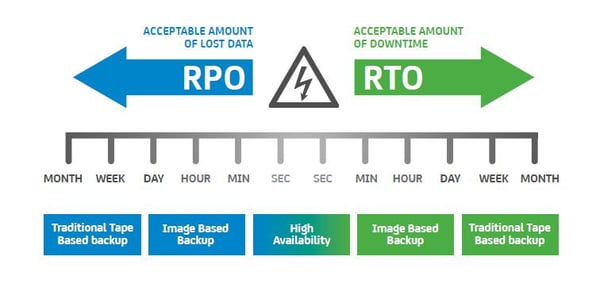Do you need to backup your systems? Absolutely. Is backup enough to support your business? Absolutely not. Disasters, no matter how you define them, are going to happen. How you prepare will determine the difference between business as usual and costly downtime. Yet there is more than just money at stake. Unfortunately, according to FEMA 40% of businesses will never reopen after a disaster, and for those that do 29% will fail within 2 years. Without intelligent business continuity you risk time, security, and peace of mind. Ask yourself, can your company afford to wait for the slow recovery times of traditional backups? Can you risk untested backups? Can you sleep soundly at night knowing that 50% of tape backups fail? Can you rely on only one backup location? With so much at stake it’s imperative to have a good understanding of the process and objectives of business continuity, the two main objectives of which are Recovery Point Objective (RPO) and Recovery Time Objective (RTO).
Without intelligent business continuity you risk time, security, and peace of mind. Ask yourself, can your company afford to wait for the slow recovery times of traditional backups? Can you risk untested backups? Can you sleep soundly at night knowing that 50% of tape backups fail? Can you rely on only one backup location? With so much at stake it’s imperative to have a good understanding of the process and objectives of business continuity, the two main objectives of which are Recovery Point Objective (RPO) and Recovery Time Objective (RTO).
Recovery Point Objective
The RPO is the age of the files recovered from backup storage that are necessary for normal operations to resume. RPO focuses on the past. For example, if the RPO is one hour, backups are made at least once per hour. This means in the event of a disaster, you would potentially lose up to one hour worth of data. When reviewing your business continuity plan it’s critical for your organization to determine how much data it’s willing to give up should the backups be required to get things operational.
Recovery Time Objective
The RTO is the maximum amount of time that a system can be down. RTO is thinking about the future and determining, realistically, how long your company can be down for before the loss - in both revenue and data - and the cost of getting systems back online, becomes insurmountable. In some instances it may be cost-effective to lose a server for a week, while in others every minute of downtime could mean critical data, customer, or revenue loss. The essential question to answer is how long can you afford to be in the dark?
Armed with the understanding of your unique business continuity objectives, it becomes crucial to have regular training and testing to make sure you meet your goals. Making sure your backup and disaster recovery plan executes smoothly, and within the predetermined parameters of your RPO and RTO, is the key to ensuring that the lights stay on, productivity remains high, and business continues to flow.
Find out how your business will handle a disaster with our Recovery Time Calculator.
See how iuvo Technologies helps businesses stay productive, efficient, and ahead of the competition:
-1.png?width=350&height=117&name=iuvo_logo_blue_Transparent%20(1)-1.png)